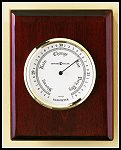|
• If the tube is placed on an angle, the surface
of the mercury remains level, and the
vertical height remains the same.
• At the top of a mountain, the height of the mercury column is less. This is because the air pressure decreases as we climb. Thus the air pressure is inversely proportional to the height (above sea level, say).
 A barometer measures air pressure.
A barometer measures air pressure. 